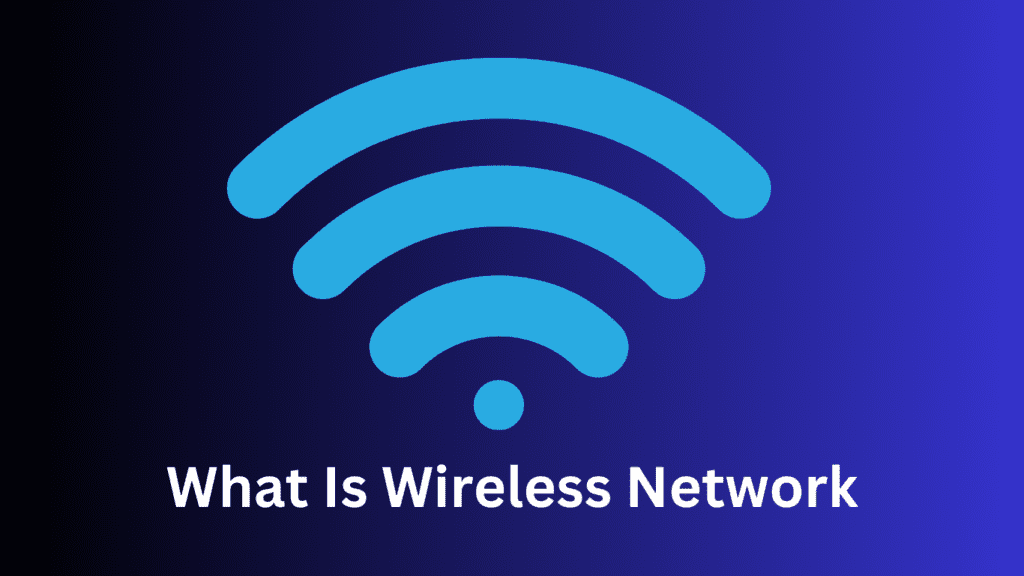What Is Wireless Network
Wireless networks have become an integral part of our daily lives, but have you ever wondered, “What is a wireless network?” Well, get ready to dive into the amazing world of wireless technology!
Imagine a world where you can connect to the internet without any pesky wires. That’s exactly what a wireless network allows you to do. It’s like magic, but with technology instead of a wand!
A wireless network uses radio signals to send and receive data, allowing you to access the internet, stream videos, play games, and connect with friends, all without the hassle of cables. It’s convenient, fast, and oh-so-cool! So, let’s explore the wonders of wireless networks together. Are you ready? Let’s go!

What is the definition of a wireless network?
A wireless network is a modern communication system that enables devices to connect and communicate with each other without the need for physical cables or wired connections. It relies on wireless technology, such as radio waves or infrared signals, to transmit data between devices and networks. The fundamental concept behind a wireless network is to provide seamless connectivity and data exchange between devices within a specific coverage area. Here’s a more detailed breakdown of the definition and components of a wireless network:
Wireless Communication:
Wireless networks use electromagnetic signals, such as radio waves, to establish communication between devices. These signals are transmitted through the air, allowing devices to send and receive data without being physically connected by cables.
Devices and Endpoints:
Devices that are part of a wireless network can include smartphones, laptops, tablets, IoT (Internet of Things) devices, and more. These devices have built-in wireless capabilities, such as Wi-Fi, Bluetooth, or cellular connectivity, that allow them to communicate with other devices and access the internet.
Access Points and Routers:
In a wireless network, access points or routers play a crucial role. These devices facilitate communication by creating wireless signals that devices can connect to. Access points are often used in larger networks to extend coverage and provide a seamless experience across a broader area.
Network Protocols:
Wireless networks use specific protocols to ensure smooth communication between devices. Common protocols include Wi-Fi (Wireless Fidelity), which is used for local wireless connections within a specific range, and cellular networks like 4G and 5G, which provide wider area coverage for mobile devices.
Coverage Area:
The coverage area of a wireless network depends on factors like the technology used, the strength of the signal, and any obstacles that might interfere with signal propagation. Wireless networks can cover small areas, such as a home or office, or larger areas, such as a city or region.
Advantages:
Wireless networks offer several benefits, including mobility (devices can move freely within the coverage area), convenience (no need for physical connections), and scalability (additional devices can be easily added to the network). They are particularly valuable in situations where wired connections are impractical or impossible.
Challenges:
While wireless networks provide flexibility, they can be susceptible to signal interference, security concerns, and signal degradation over longer distances or in areas with obstacles like walls or buildings.
Applications:
Wireless networks are integral to modern communication, supporting applications ranging from internet access and online streaming to remote monitoring and control of IoT devices.
Wireless network is a communication infrastructure that enables devices to connect and communicate without the use of physical cables. It’s a cornerstone of modern connectivity, providing the convenience and flexibility needed to support our increasingly wireless world.
What is a Wireless Network: Connecting Without Cables
In our increasingly connected world, wireless networks have become a crucial part of our daily lives. From browsing the internet on our smartphones to streaming our favorite shows on smart TVs, we rely on wireless networks to keep us connected and entertained. But what exactly is a wireless network? In this article, we will explore the ins and outs of wireless networks, how they work, and their benefits.
How Do Wireless Networks Work?
At their core, wireless networks use radio waves to transmit and receive data without the need for physical cables. The key components of a wireless network include a wireless access point, wireless devices, and the underlying infrastructure that supports the network.
When you connect to a wireless network, your device sends and receives electromagnetic waves through the air. These waves, operating in specific frequency bands, carry data between your device and the wireless access point, which is connected to a wired network infrastructure. The wireless access point acts as a bridge between the wireless and wired networks, enabling devices to communicate without the need for physical connections.
Wireless networks utilize various wireless communication standards, such as Wi-Fi and Bluetooth, to establish connections and enable data transfer. These standards set rules and protocols for transmitting and receiving data, ensuring compatibility between devices and network infrastructure.
Wi-Fi vs. Cellular Networks: A Comparison
While both Wi-Fi and cellular networks provide wireless connectivity, they differ in their coverage, bandwidth, and usage scenarios.
Wi-Fi: Wi-Fi refers to wireless networks that use the IEEE 802.11 standard. It is typically used for local area networks (LANs) in homes, offices, and public spaces. Wi-Fi networks have limited coverage areas, but they offer higher bandwidth and faster speeds compared to cellular networks. They are ideal for connecting multiple devices in a specific area and providing internet access.
Cellular Networks: Cellular networks, on the other hand, rely on cellular towers to provide wireless connectivity over larger geographic areas. They use different generations of cellular standards like 3G, 4G, and 5G to deliver voice and data services to mobile devices. Cellular networks offer broader coverage but may have lower bandwidth and higher latency compared to Wi-Fi networks. They excel in providing connectivity on the move and in areas without Wi-Fi coverage.
Tips for Securing Your Wireless Network
Securing your wireless network is essential to protect your data and prevent unauthorized access. Here are some tips to enhance the security of your wireless network:
Change Default Passwords: Always change the default passwords and usernames of your wireless access points and routers to something unique and secure.
Enable Encryption: Use encryption protocols like WPA2 or WPA3 to encrypt data transmitted over your wireless network. This prevents eavesdropping.
Set up a Guest Network: If you frequently have visitors who need access to your internet connection, set up a separate guest network to keep your main network secure.
Keep Firmware Up to Date: Regularly update the firmware of your routers and wireless access points to patch any security vulnerabilities.
Disable Remote Management: Disable the option for remote management of your wireless devices to prevent unauthorized access.
Benefits of wireless networks?
Wireless networks have revolutionized the way we connect and communicate, offering a wide range of benefits that have transformed the digital landscape. From convenience to scalability, here’s a detailed look at the advantages of wireless networks:
Mobility and Flexibility:
Perhaps the most significant advantage of wireless networks is the freedom of movement they provide. Users can access the internet, communicate, and share data from anywhere within the network’s coverage area. This mobility is especially crucial in today’s fast-paced world where staying connected on the go is a necessity.
Convenience and Easy Setup:
Wireless networks eliminate the need for physical cables and complex installations. Setting up a wireless network requires minimal hardware – usually a router or access point – making it straightforward for both residential users and businesses. This ease of setup translates to time and cost savings.
Scalability:
Wireless networks are highly scalable. Additional devices can be seamlessly connected to the network without the need for extensive cabling or infrastructure changes. This makes them perfect for environments where the number of devices can fluctuate frequently, such as workplaces and public spaces.
Cost-Efficiency:
Wireless networks often prove to be cost-effective over time. The reduction in cabling and associated installation expenses can result in significant cost savings. Moreover, the ability to add devices without major infrastructure adjustments contributes to long-term cost-efficiency.
Accessibility:
Wireless networks enhance digital inclusion by providing access to the internet in areas where wired connections might be challenging or impossible to implement. This is particularly valuable in remote or underserved regions, improving connectivity for educational, social, and economic purposes.
Remote Access and Monitoring:
Wireless networks enable remote access and monitoring of devices and systems. This is especially valuable for industries like home automation, healthcare, and industrial automation, allowing users to control and monitor devices from afar.
Enhanced Collaboration:
Wireless networks foster collaboration by enabling seamless data sharing among users. This is advantageous in educational settings, business environments, and team projects, where data exchange is vital for productivity.
IoT Connectivity:
The rise of the Internet of Things (IoT) relies heavily on wireless networks. IoT devices, which include smart home gadgets, wearable technology, and sensors, require wireless connectivity to communicate and share data.
Reduced Clutter and Flexibility:
Eliminating the need for physical cables reduces clutter and allows for more flexible workspace arrangements. Devices can be positioned wherever needed, contributing to a clean and organized environment.
Rapid Deployment:
In situations where immediate connectivity is required, wireless networks offer a rapid deployment option. Temporary setups for events, disaster response, or field operations can benefit from wireless connectivity without the need for extensive infrastructure changes.
Technological Advancements:
Wireless networks continually evolve, adopting new technologies to improve performance and security. The transition from 4G to 5G, for instance, promises faster speeds, lower latency, and enhanced network capacity.
Global Connectivity:
Wireless networks enable global connectivity. As long as there’s coverage, users can access data and communicate internationally, making them invaluable for travelers and businesses with a global presence.
Benefits of wireless networks span from enhanced mobility and convenience to scalability, cost-efficiency, and improved collaboration. As wireless technology continues to advance, these networks will remain integral to modern communication, shaping how we connect, work, and interact in the digital age.
How to deploy a wireless network
Deploying a wireless network involves several steps to ensure a reliable and efficient connection. Whether for a home, office, or public space, here’s a comprehensive guide to help you deploy a wireless network:
Planning and Design:
Determine the coverage area: Identify the space where you need wireless coverage.
Consider obstacles: Take note of walls, floors, and potential signal-blocking elements.
Estimate device count: Assess how many devices will connect to the network simultaneously.
Choose technology: Decide on Wi-Fi standards (e.g., 802.11ac, 802.11ax) and frequency bands (2.4 GHz, 5 GHz) based on your needs.
Selecting Equipment:
Choose a router or access point: Select a device that suits your coverage area and device count.
Consider mesh systems: For larger spaces, mesh systems offer multiple access points for better coverage.
Preparation:
Ensure power supply: Access points need a stable power source.
Positioning: Strategically place access points to maximize coverage and minimize signal interference.
Configuration:
Access point setup: Follow the manufacturer’s instructions to set up the access points.
Network name (SSID): Choose a unique, recognizable name for your network.
Security: Set up WPA3 or WPA2 encryption to secure the network.
Guest network: If needed, create a separate network for guests with limited access.
Installation:
Mounting: Physically install access points in chosen locations (e.g., ceilings, walls).
Cable connection: Connect access points to power sources and, if possible, wired networks.
Testing and Optimization:
Signal strength: Use a Wi-Fi analyzer to test signal strength and coverage throughout the area.
Speed test: Check the network’s performance using online speed tests.
Signal interference: Identify and address potential sources of signal interference.
Network Management:
Firmware updates: Keep access point firmware up to date for security and performance improvements.
Monitoring tools: Use management software to monitor network health and diagnose issues.
Quality of Service (QoS): Set priorities for different types of traffic to ensure optimal performance.
Security:
Change default passwords: Update default passwords for access points to enhance security.
Firewall settings: Configure firewalls to block unauthorized access and protect against threats.
Documentation:
Record details: Maintain a record of access point locations, settings, and passwords for future reference.
User Education:
Share network details: Provide users with the network name and password.
Best practices: Educate users about network security practices and responsible usage.
Regular Maintenance:
Periodic checks: Regularly assess network performance and address any issues promptly.
Updates: Keep access point firmware, security protocols, and software up to date.
Scalability:
Add more access points: If coverage needs change, consider adding more access points.
Deploying a wireless network involves careful planning, equipment selection, configuration, testing, and ongoing maintenance. By following these steps, you can create a reliable wireless network that meets your connectivity needs.
How Does Wi-Fi Network Work?


Wi-Fi, short for Wireless Fidelity, is a technology that enables devices to connect to the internet and communicate with each other wirelessly. It has become an integral part of our modern lives, allowing us to access the internet, stream media, and share data without the need for physical cables. Here’s a detailed explanation of how Wi-Fi networks work:
Signal Transmission:
Wi-Fi networks use radio frequency (RF) signals to transmit data between devices and access points (APs).
Access points serve as hubs that transmit and receive data from connected devices. They are typically connected to a wired network, which provides internet access.
Frequency Bands:
Wi-Fi operates in two primary frequency bands: 2.4 GHz and 5 GHz.
The 2.4 GHz band offers better coverage and can penetrate walls and obstacles more effectively, but it may be prone to congestion due to interference from other devices like microwaves and cordless phones.
The 5 GHz band provides faster speeds and less interference, making it suitable for high-bandwidth activities.
Communication Protocols:
Wi-Fi devices use standardized communication protocols, such as IEEE 802.11a/b/g/n/ac/ax.
These protocols define how data is transmitted and received between devices and access points.
Device Connection:
Devices like smartphones, laptops, and smart TVs have Wi-Fi capabilities built in. When a device is within the coverage area of a Wi-Fi network, it scans for available networks and displays a list of SSIDs (network names). Users select a network, enter the network password (if required), and establish a connection.
SSID and Authentication:
The Service Set Identifier (SSID) is the name of the Wi-Fi network. It helps devices identify and connect to the correct network. To ensure security, most Wi-Fi networks are password-protected. Devices must provide the correct password (WPA2 or WPA3) to join the network.
Data Transmission:
Once connected, devices can send and receive data packets over the Wi-Fi network. Data packets are broken down into smaller units and transmitted in bursts. The access point manages the flow of data between devices and the wired network.
Modulation and Encoding:
Modulation techniques convert digital data into radio waves that can be transmitted and received. Encoding schemes ensure that data remains intact during transmission, even in the presence of noise and interference.
Signal Strength and Range:
Signal strength determines the quality of the connection. Closer proximity to the access point usually results in stronger signals and faster speeds. The range of a Wi-Fi signal depends on factors like frequency band, signal strength, and obstacles like walls and buildings.
Data Security:
WPA2 (Wi-Fi Protected Access 2) and WPA3 are encryption protocols that ensure data security by encrypting data transmitted between devices and access points. These protocols prevent unauthorized access and eavesdropping on network communications.
Wi-Fi networks use radio frequency signals to transmit data wirelessly. Devices connect to access points using standardized communication protocols, and data is transmitted in data packets over designated frequency bands. Security measures like authentication and encryption ensure safe and secure data exchange, making Wi-Fi an essential technology for modern communication and connectivity.
FAQs
What are the advantages of wireless networks over wired networks?
Wireless networks offer benefits like mobility, easy setup, and scalability. They eliminate the need for physical cables, providing flexibility in device placement. This is particularly useful for mobile devices and environments where wired connections are impractical.
What factors affect the performance of a wireless network?
Several factors impact wireless network performance:
Signal Strength: Stronger signals result in better performance and coverage.
Interference: Other electronic devices or neighboring networks can interfere with signal quality.
Obstacles: Walls and physical barriers can weaken signals and reduce coverage.
Number of Devices: More devices connected can lead to congestion and slower speeds.
Frequency Band: The 5 GHz band typically offers faster speeds but shorter range compared to the 2.4 GHz band.
Can I improve the range of my wireless network?
Yes, you can enhance coverage by:
Positioning: Place the router or access point in a central location.
Signal Boosters/Repeaters: These extend coverage in dead zones.
Mesh Systems: Use multiple access points for broader coverage in larger areas.
Optimizing Antennas: Adjust antennas for optimal signal propagation.




